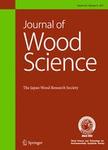版权所有:内蒙古大学图书馆 技术提供:维普资讯• 智图
内蒙古自治区呼和浩特市赛罕区大学西街235号 邮编: 010021

作者机构:Tokyo Metropolitan Ind Technol Res Inst Koto Ku 2-4-10 Aomi Tokyo 1350064 Japan Toyama Prefectural Agr Forestry & Fisheries Res C 4940 Imizu Toyama 9390311 Japan Sugiyama Jogakuen Univ Chikusa Ku Nagoya Aichi 4648662 Japan Kyoto Univ Res Inst Sustainable Humanosphere Uji Kyoto 6110011 Japan Univ Fukui Fukui Fukui 9108507 Japan
出 版 物:《JOURNAL OF WOOD SCIENCE》 (J. Wood Sci.)
年 卷 期:2017年第63卷第6期
页 面:625-634页
核心收录:
学科分类:0907[农学-林学] 08[工学] 0829[工学-林业工程] 09[农学] 0805[工学-材料科学与工程(可授工学、理学学位)]
基 金:Science and Technology Research Promotion Program for Agriculture Forestry Fisheries and Food Industry
主 题:Lag screw joints Clamp force Pull-out strength Tightening test
摘 要:This study empirically examines the relationship between clamp force and pull-out strength in lag screw joints of timber members, using data obtained in tightening tests and pull-out tests. Maximum clamp force per unit screw length as determined from the tightening tests was lower than the lower bound for the 95% tolerance range for pull-out strength per unit screw length as determined from the pull-out tests. Moreover, X-ray CT (computed tomography) observations of anchor members from both tests revealed that failure behavior clearly differed between the tightening test and the pull-out test: tightening caused damage to the wooden, female thread in addition to major splitting damage in the wood perpendicular to the grain near the tip of the lag screw.